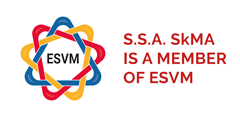Ergotism – recurrent acute limb ischemia in a young woman
Authors
- I. Vacula
Angiological-Internal Outpatient Lab, Trnava - E. Ambrózy
1st Department of Internal Medicine, Comenius University Hospital, Bratislava - A. Haršány
Clinic of Radiology, Faculty Hospital, Trnava
Introduction
Ergotamin (EA) – a well known poisonous alkaloid from fungus Claviceps purpurea parasiting on rye. It is a recognised cause of epidemic intoxications in Middle Age (1). The acute intoxication after consume manifested as the St. Anthony’s fire in modern era is very unlikely. But the chronic abuse of antimigraene drugs containing EA is still important potential cause of acute limb ischemia (ALI) especially in younger adults . Lately, there has been several case reports about severe interactions in HIV patients suffering for migraene (2).
Case report
A 34 year old woman with a history of hypothyreosis and severe chronic migraene was presented with severe rest pain of both lower extremities, with much worse symptoms in her left leg. Reumathologist has sent her with the suspicion on primary vasculitis– Takayasu type. 2 attacks of severe cramps and chest pain were also described by the patient. On the physical examination, the left leg was pale and pulseless below the knee level including popliteal artery, the left ABI (Ankle brachial index) less than 0,4. On ultrasound examination there were no signs of atherosclerosis or vasculitis. There were severe long and narrow stenotic changes on left femoral artery with pulsus parvus et tardus below this level. All laboratory findings were within normal ranges and ECG did not show any pathologic changes. After the patient disclosed overuse of antimigraene suppositories (mixture of: ergotamin, coffein, diazepam, phenobarbital) on a daily base, she was immidiately given intravenous alprostadil with the subsequent relief of symptoms of ischemia, but with persistent neuropatic pain in her left feet. Psychiatric examination revealed pathologically changed personality and refered the patient to regular outpatient care. The neurologist recommended pregabalin and thioctic acid for postischemic neuropathy. Despite the severity of symptoms and our strong recommendation, the patient was noncompliant, continued in the abuse of antimigraene suppositories leading herself to strong addiction (phenobarbital and diazepam). This behavior led to 2 other attacks of acute ischemia in next 8 years of follow up, both of them affected both legs. She was treated with intraarterial vasodilatators with subsequent relief of the rest pain (Pictures 1,2 before, 3,4 – after administration of the drug)). Despite the therapy, there are residual non limiting claudications and postischemic neuropathy. According to the last phone contact with the patient (02/2024), she is doing quite well, without further episodes of ALI, on a regular treatment of migraenes lead by neurologist (although she still admits occasional use of suppositories).
Conclusion
Our report is one of those rare cases, that appear every year almost all over the world. It is not important because of the impact on daily practise, but should be a reminder to all physicians how the history of a patient is still the main clue to correct diagnosis and thus, to the best choice of treatment. The intraarterial vasodilatators are now the treatment of first choice. These patients often require multidisciplinary approach in the follow up, that includes vascular specialist, radiologist, psychiatrist and in our case, also neurologist.
Literature
- Liegl CA, McGrath MA. Ergotism: Case Report and Review of the Literature. Int J Angiol. 2016 Dec;25(5):e8-e11. doi: 10.1055/s-0034-1376397. Epub 2015 Feb 9. PMID: 28031641; PMCID: PMC5186301.
- Hostench-Junoy N, Ramírez-Montoya M, Arefai-Refai B, et al. Acute Ischemia of Lower Extremities Caused by Ergotamine Toxicity due to Pharmacologic Interaction With Cobicistat in an HIV-Positive Patient. Annals of Vascular Surgery, Volume 80, 2022, Pages 392.e1-392.e6, ISSN 0890-5096.










